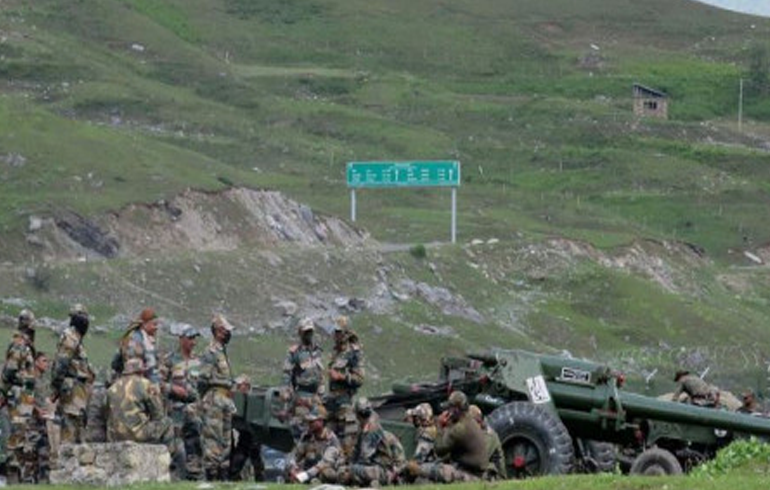China and India have accused each other of provoking fighting in which at least 20 Indian soldiers were killed in a disputed Himalayan border area.
Soldiers reportedly brawled with sticks, bats and bamboo sticks studded with nails in the late-night confrontation in the Ladakh region on Monday.
However, no shots were fired.
India’s army said that both sides suffered casualties. China confirmed the incident but did not give details.
The Indian statement notes that injured soldiers were “exposed to sub-zero temperatures in the high altitude terrain”.
It is the first deadly clash between the two sides in the border area, in the disputed Kashmir region, in at least 45 years.
India said China had tried to “unilaterally change the status quo”. Beijing accused Indian troops of “attacking Chinese personnel”.
The two armies later held talks to try to defuse tensions.
What happened?
The fighting occurred in the precipitous, rocky terrain of the strategically important Galwan Valley, which lies between China’s Tibet and India’s Ladakh.
Indian media say soldiers engaged in direct hand-to-hand combat, with some “beaten to death”. During the fight, one newspaper reported, others fell or were pushed into a river.
The Indian army initially said a colonel and two soldiers had died. It later said that “17 Indian troops who were critically injured in the line of duty” and died from their injuries, taking the “total that were killed in action to 20”.
Both sides insist no bullet has been fired in four decades, and the Indian army said on Tuesday that “no shots were fired” in this latest skirmish.
India’s foreign ministry spokesman Anurag Srivastava said the clash arose from “an attempt by the Chinese side to unilaterally change the status quo” on the border.
China did not confirm the number of casualties, but accused India in turn of crossing the border onto the Chinese side.
The clash has provoked protests in India, with people burning Chinese flags.
Indian Prime Minister Narendra Modi has been under pressure to publicly address the issue, including from Rahul Gandhi, former leader of the opposition Indian National Congress part
In a tweet, Mr Modi called for an all-party meeting on Friday to discuss the situation, but did not make any other comment on the confrontation.
Meanwhile, India Defence Minister Rajnath Singh tweeted on Wednesday: “The loss of soldiers in Galwan is deeply disturbing and painful.
“Our soldiers displayed exemplary courage and valour in the line of duty and sacrificed their lives in the highest traditions of the Indian Army.”
Why was the clash so lethal?
The fighting on the border in Ladakh was the worst in nearly half a century.
This is not the first time the two nuclear-armed neighbours have fought without conventional firearms on the border. India and China have a history of face-offs and overlapping territorial claims along the more than 3,440km (2,100 mile), poorly drawn Line of Actual Control (LAC) separating the two sides.
Border patrols have often bumped into each other, resulting in occasional scuffles. But no bullets have been fired in four decades.
And at the root of this is a 1996 bilateral agreement that says “neither side shall open fire… conduct blast operations or hunt with guns or explosives within two kilometres of the Line of Actual Control”.
Both countries send out patrols that often engage in physical stand-offs. Last month dozens of Indian and Chinese soldiers exchanged physical blows in a clash on the shared border in the state of Sikkim. Seven Chinese and four Indian troops were injured.
When things get worse, the two sides end up fighting with makeshift weapons.
“It’s grim stuff. Blunt force trauma. Bludgeoning,” Vipin Narang, a security studies professor at Massachusetts Institute of Technology, told me.
“The trade-offs is fewer potential fatalities, but the method of death is medieval.”
How tense is the area?
The LAC is poorly demarcated. The presence of rivers, lakes and snowcaps means the line can shift. The soldiers either side – representing two of the world’s largest armies – come face-to-face at many points.
The last firing on the border happened in 1975 when four Indian soldiers were killed in a remote pass in the north-eastern state of Arunachal Pradesh. The clash was variously described by former diplomats as an ambush and an accident.
But there have been tense confrontations along the border in recent weeks.
India has accused China of sending thousands of troops into Ladakh’s Galwan Valley and says China occupies 38,000sq km (14,700sq miles) of its territory. Several rounds of talks in the last three decades have failed to resolve the boundary disputes.
The two countries have fought only one war so far, in 1962, when India suffered a humiliating defeat.
There are several reasons why tensions are rising again now – but competing strategic goals lie at the root, and both sides blame each other.
India has built a new road in what experts say is the most remote and vulnerable area along the LAC in Ladakh. And India’s decision to ramp up infrastructure seems to have infuriated Beijing.
India also disputes part of Kashmir – an ethnically diverse Himalayan region covering about 140,000sq km – with Pakistan.
Following the latest clash between China and India, the United Nations urged both sides “to exercise maximum restraint”.
“We take positive note of reports that the two countries have engaged to de-escalate the situation,” UN associate spokesperson Eri Kaneko said.
A US State Department spokesman, meanwhile, said it was “closely monitoring” the situation and that the US supports a peaceful resolution.
Source: BBC




















































